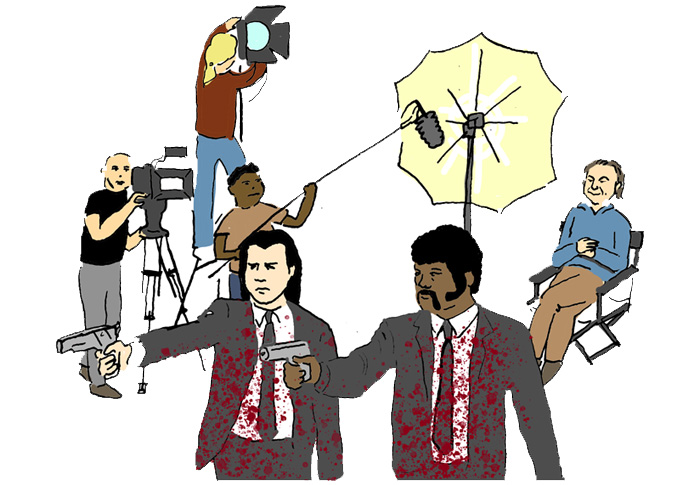The first time vandals defaced his sculpture, Dirty Corner, at Versailles, artist Anish Kapoor wrote an essay in which he considered his options:
Should the paint that has been thrown all over the sculpture be removed? Or should it remain and be part of the work? Does the political violence of the vandalism make Dirty Corner “dirtier”? Does this dirty political act reflect the dirty politics of exclusion, marginalisation, elitism, racism, Islamophobia?
The question I ask of myself is: can I, the artist, transform this crass act of political vandalism and violence into a creative act? Would this not be the best revenge?
Sometimes artists are the ones behind the vandalism.
Ai Weiwei starred in a 1995 black-and-white photo triptych that documents his intentional destruction of a Han Dynasty urn from his private collection.
Brothers Jake and Dinos Chapman purchased a mint condition set of Goya’s The Disasters of War, painstakingly re-rendered the victims’ heads as grotesquely cute, colorful cartoons, and exhibited the altered etchings under the title Insult to Injury.
Robert Rauschenberg sought and received permission to erase a drawing that his fellow Abstract Expressionist Willem de Kooning had given him, at his request.
Certainly, artists of all stripes have been known to eradicate their own work in fits of pique, passion, and self-reproach.
But until last week, no artist had ever vandalized their own work with such a dispassionate, pre-meditated sense of fun as Banksy, the anonymous clown prince of street art and massive scale pranks.
As you’ve likely heard by now, within seconds of his iconic Girl With Balloon (2006) selling at Sotheby’s for £1,042,000—$1.4 million—the painting began to self-destruct, thanks to a custom-built shredder the artist had pre-loaded into its frame.
No one seemed particularly distressed about it.
Auction attendees quickly scrambled to capture the moment with their cell phones.
Auctioneer Oliver Barker looks on in admirably mild confusion.
No self-appointed hero rushed forward to jam the works with an umbrella or broom handle.
The as-yet-unidentified buyer was not in the room, no doubt to their ever-lasting regret. Imagine losing out on those bragging rights!
While Sotheby’s and the buyer hammer out their unprecedented next steps, some art experts have stated that it would be possible, given the clean geometry of the cuts, to restore the canvas.
Though who would want to, given the speculation that this stunt immediately increased the value of the work, anywhere from 50% to near double the purchase price?
Perhaps the buyer will choose to finish the job and sell it off strip-by-strip.
Office supply stores will see an uptick in shredder sales to vendors selling Banksy knock-offs stencilled on subway maps.
Sotheby’s senior director, Alex Branczik, insisted that no one there was in on the joke, but The New York Times smells a rat:
The frame would presumably have been rather heavy and thick for its size, something an auction house specialist or art handler might have noticed. Detailed condition reports are routinely requested by the would-be buyers of high-value artworks. Unusually, this relatively small Banksy had been hung on a wall, rather than placed by porters on a podium for the moment of sale.
The fact that Girl with Balloon was the final item on the block is either a great piece of luck, or a bit of canny stage management on the auction house’s part. Recapturing the attendees’ attention after that stunt would be an uphill battle.
It’s doubtful that buyers will shy away from Sotheby’s as a place where highly valued artwork starts to devour itself the moment the gavel comes down. That kind of lightning strikes but once.
What may circle back to bite the venerable firm in its well padded rear is the ease with which someone in the crowd was able to activate the mayhem, using a device concealed in his bag. What’s worse, lax security or maybe lying about foreknowledge of the prank? It’s hard not to raise those as possibilities.
The man with the bag was escorted out. Not even the conspiracy theorists are pegging him as Banksy.
As for the steady-handed fellow another attendee caught calmly zooming in on his phone from the perfect angle… well, let’s just say the tabloids have picked up on his resemblance to Robin Gunningham, oft thought to be Clark Kent to Banksy’s Superman.
Banksy’s post-mortem, unlike Kapoor’s, does not suggest a man tortured by unresolved questions.
“A few years ago I secretly built a shredder into a painting, in case it was ever put up for auction,” he wrote on his Instagram. “Going, going, gone.”
Related Content:
Patti Smith Presents Top Webby Award to Banksy; He Accepts with Self-Mocking Video
Ayun Halliday is an author, illustrator, theater maker and Chief Primatologist of the East Village Inky zine. Join her in NYC on Monday, October 15 for another monthly installment of her book-based variety show, Necromancers of the Public Domain. Follow her @AyunHalliday.






